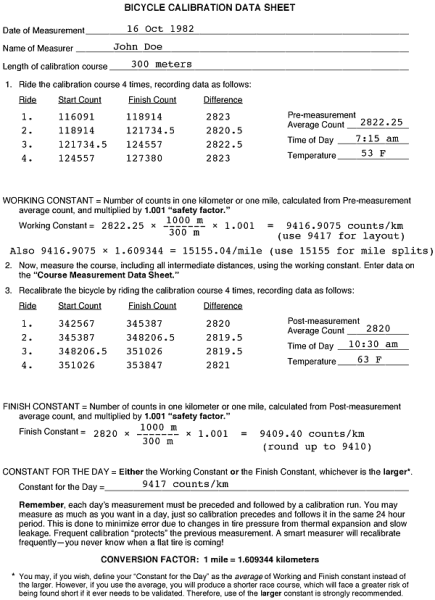
APPENDIX C - Example of Course Measurement
Calibrating the Bicycle
You take your bicycle with tires fully inflated and your pack of equipment out to the calibration course you previously submitted for certification. It is 7:15 a.m. You determine the temperature as before (53 °F) and ride the bicycle around for roughly five minutes to warm up the tires. You record the time and temperature.
You position the front axle of the bicycle over the start point on the calibration course. You record the start count as 116091. You ride the calibration course, carrying your equipment. You carefully stop the bicycle with the front axle positioned directly over the end point. You record the finish count as 118914.
You then repeat this procedure three more times, recording the start and finish counts. Each time you reverse direction, you freeze the front wheel with the handbrake before turning the bike around. In this way, your finish count for one ride is your start count for the next ride. This isn’t required, but simplifies the arithmetic and helps ensure accuracy of your average count, even if there are errors in intermediate counter readings.
You now sit down and fill in the first part of the Bicycle Calibration Data Sheet. The average pre-measurement count works out to 2822.25 counts on your 300 meter calibration course. To figure the counts in one kilometer (i.e., 1000 meters), you multiple by the ratio 1000/300. Then multiply by the 1.001 safety factor. Your resulting working constant is 9416.9075 counts per kilometer. You round this upwards to 9417 and will use this value for preliminary course markings.
Since you also intend to mark some mile splits, you multiply the 9416.9075 figure by the conversion factor of 1.609344 (see Appendix E) to obtain a mile constant of 15155.04, which you round to 15155 counts/mile. (It's safest to round constants upwards; however the rounding here is minor, and you weren’t planning to certify the mile splits anyway).
You now measure the course (see next section).
After you have completed your two measurements of the race course, you return to the calibration course. It is now 10:30 a.m. You check the temperature and record 63 °F.
You calibrate the bicycle just as you did for the pre-measurement calibration with four rides. Your resulting finish constant works out to 9409.40 counts/km, which you round upwards to 9410 counts/km.
Since the finish constant is smaller than the working constant, the constant for the day is taken to be the working constant or 9417 counts/km. If you start your measurements in the early morning, you will generally find your working constant to be larger than your finish constant. This means that the preliminary course marks will not need to be adjusted for the change in the bicycle calibration.

| Go to Next Section: | Appendix C - Example - Measuring the Race Course |
| Previous Section: | Appendix C - Example - Setting Up Calibration Course |
| Back to: | Table of Contents |